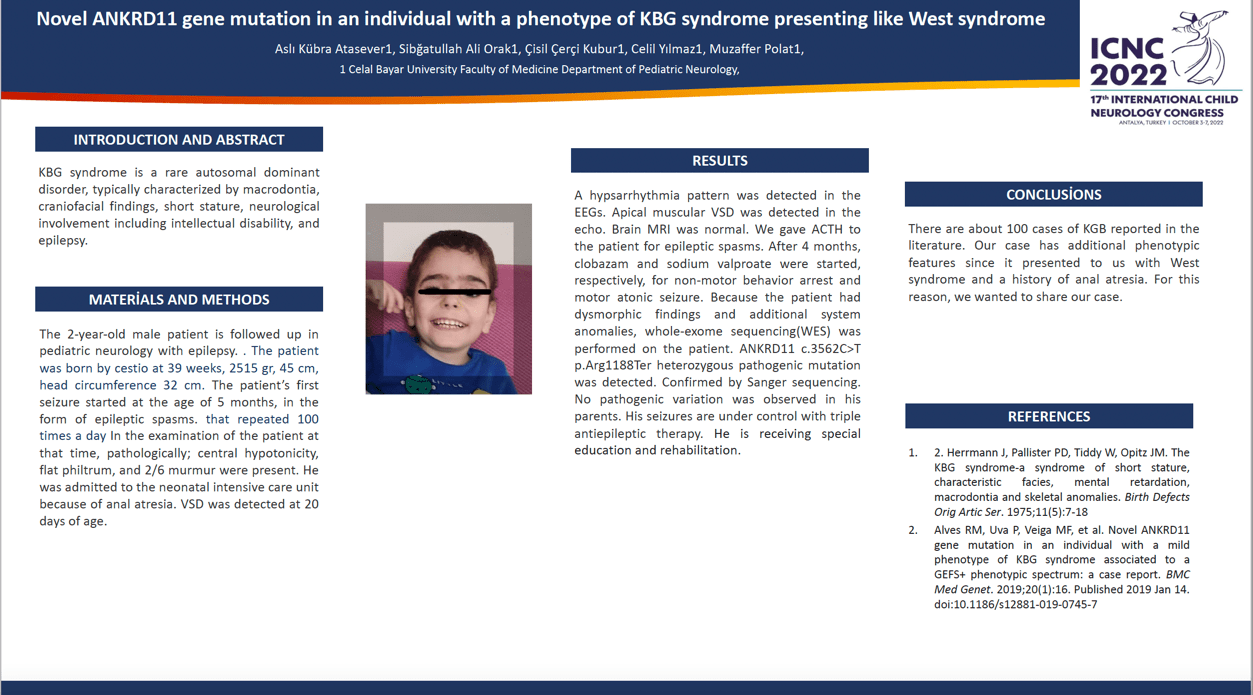Novel ANKRD11 gene mutation in an individual with a phenotype of KBG syndrome presenting like West syndrome
ASLI KÜBRA ATASEVER, Sibğatullah Ali ORAK, Çisil Çerçi KUBUR, Muzaffer POLAT
Objectives: KBG syndrome is a rare autosomal dominant disorder, typically characterized by macrodontia, craniofacial findings, short stature, neurological involvement including intellectual disability, and epilepsy.
Methods: The 2-year-old male patient is followed up in pediatric neurology with epilepsy. The patient’s first seizure started at the age of 5 months, in the form of epileptic spasms. In the examination of the patient at that time, pathologically; central hypotonicity, flat philtrum, and 2/6 murmur were present. He was admitted to the neonatal intensive care unit because of anal atresia. VSD was detected at 20 days of age.
Results: A hypsarrhythmia pattern was detected in the EEGs. Apical muscular VSD was detected in the echo. Brain MRI normal. We gave ACTH to the patient for epileptic spasms. After 4 months, clobazam and sodium valproate were started, respectively, for non-motor behavior arrest and motor atonic seizure. Because the patient had dysmorphic findings and additional system anomalies, whole-exome sequencing(WES) was performed on the patient. ANKRD11 c.3562C>T p.Arg1188Ter heterozygous pathogenic mutation was detected. Confirmed by Sanger sequencing. No pathogenic variation was observed in his parents. His seizures are under control with triple antiepileptic therapy.
Conclusion There are about 100 cases of KGB reported in the literature. Our case has additional phenotypic features since it presented to us with West syndrome and a history of anal atresia. For this reason, we wanted to share our case.
Keywords: KBG syndrome, ANKRD11 gene, west syndrome
ASLI KÜBRA ATASEVER
ICNC 2022
Turkey
Sibğatullah Ali ORAK
ICNC 2022
Turkey
Çisil Çerçi KUBUR
ICNC 2022
Turkey
Muzaffer POLAT
ICNC 2022
Turkey
Objectives: KBG syndrome is a rare autosomal dominant disorder, typically characterized by macrodontia, craniofacial findings, short stature, neurological involvement including intellectual disability, and epilepsy.
Methods: The 2-year-old male patient is followed up in pediatric neurology with epilepsy. The patient’s first seizure started at the age of 5 months, in the form of epileptic spasms. In the examination of the patient at that time, pathologically; central hypotonicity, flat philtrum, and 2/6 murmur were present. He was admitted to the neonatal intensive care unit because of anal atresia. VSD was detected at 20 days of age.
Results: A hypsarrhythmia pattern was detected in the EEGs. Apical muscular VSD was detected in the echo. Brain MRI normal. We gave ACTH to the patient for epileptic spasms. After 4 months, clobazam and sodium valproate were started, respectively, for non-motor behavior arrest and motor atonic seizure. Because the patient had dysmorphic findings and additional system anomalies, whole-exome sequencing(WES) was performed on the patient. ANKRD11 c.3562C>T p.Arg1188Ter heterozygous pathogenic mutation was detected. Confirmed by Sanger sequencing. No pathogenic variation was observed in his parents. His seizures are under control with triple antiepileptic therapy.
Conclusion There are about 100 cases of KGB reported in the literature. Our case has additional phenotypic features since it presented to us with West syndrome and a history of anal atresia. For this reason, we wanted to share our case.
Keywords: KBG syndrome, ANKRD11 gene, west syndrome
ASLI KÜBRA ATASEVER
ICNC 2022
Turkey
Sibğatullah Ali ORAK
ICNC 2022
Turkey
Çisil Çerçi KUBUR
ICNC 2022
Turkey
Muzaffer POLAT
ICNC 2022
Turkey

ASLI KÜBRA ATASEVER
ICNC 2022 Turkey
ICNC 2022 Turkey